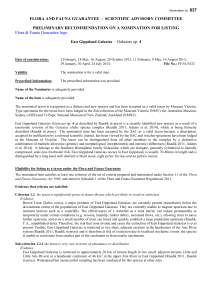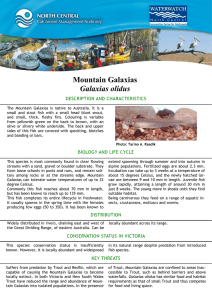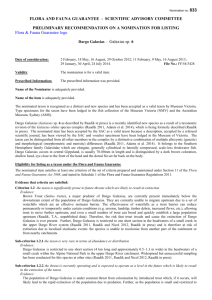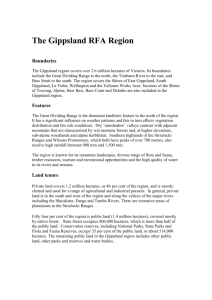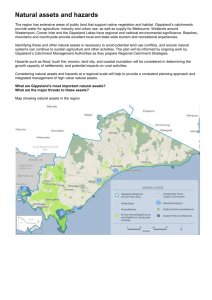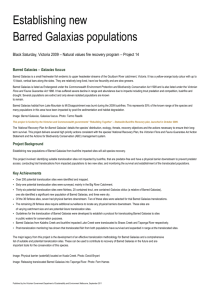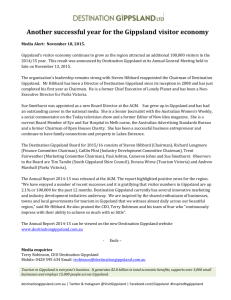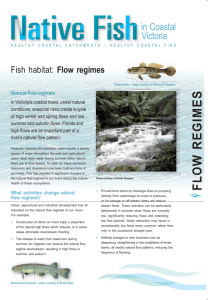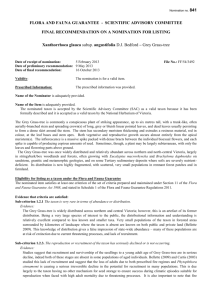Nomination no. 836 FLORA AND FAUNA GUARANTEE
advertisement
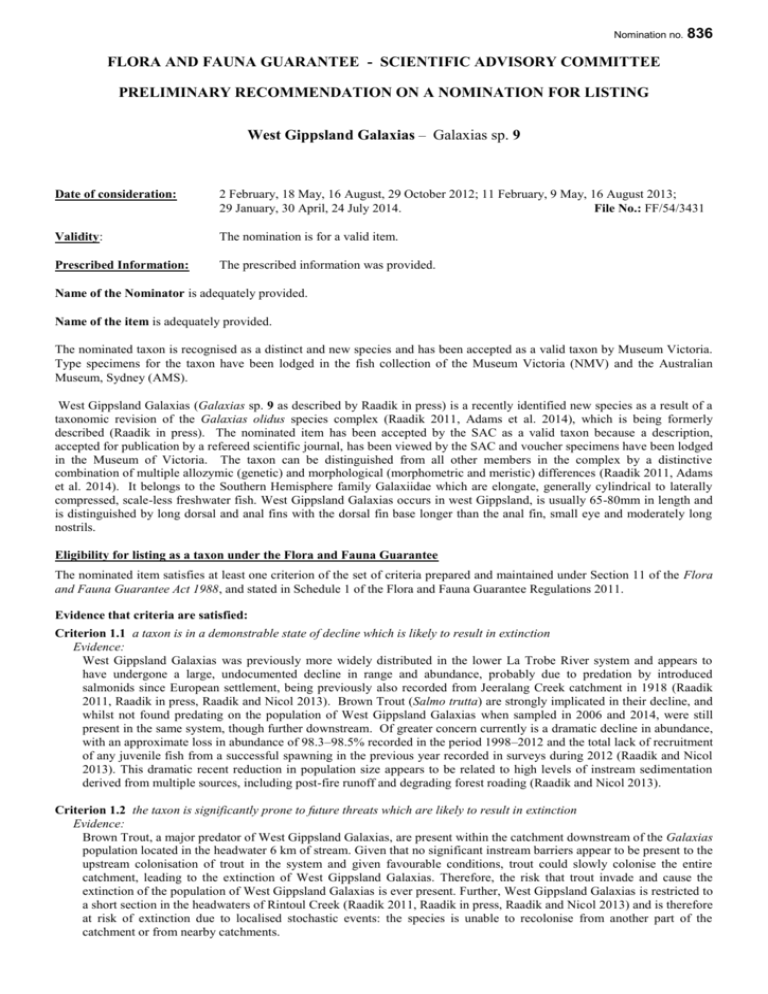
Nomination no. 836 FLORA AND FAUNA GUARANTEE - SCIENTIFIC ADVISORY COMMITTEE PRELIMINARY RECOMMENDATION ON A NOMINATION FOR LISTING West Gippsland Galaxias – Galaxias sp. 9 Date of consideration: 2 February, 18 May, 16 August, 29 October 2012; 11 February, 9 May, 16 August 2013; 29 January, 30 April, 24 July 2014. File No.: FF/54/3431 Validity: The nomination is for a valid item. Prescribed Information: The prescribed information was provided. Name of the Nominator is adequately provided. Name of the item is adequately provided. The nominated taxon is recognised as a distinct and new species and has been accepted as a valid taxon by Museum Victoria. Type specimens for the taxon have been lodged in the fish collection of the Museum Victoria (NMV) and the Australian Museum, Sydney (AMS). West Gippsland Galaxias (Galaxias sp. 9 as described by Raadik in press) is a recently identified new species as a result of a taxonomic revision of the Galaxias olidus species complex (Raadik 2011, Adams et al. 2014), which is being formerly described (Raadik in press). The nominated item has been accepted by the SAC as a valid taxon because a description, accepted for publication by a refereed scientific journal, has been viewed by the SAC and voucher specimens have been lodged in the Museum of Victoria. The taxon can be distinguished from all other members in the complex by a distinctive combination of multiple allozymic (genetic) and morphological (morphometric and meristic) differences (Raadik 2011, Adams et al. 2014). It belongs to the Southern Hemisphere family Galaxiidae which are elongate, generally cylindrical to laterally compressed, scale-less freshwater fish. West Gippsland Galaxias occurs in west Gippsland, is usually 65-80mm in length and is distinguished by long dorsal and anal fins with the dorsal fin base longer than the anal fin, small eye and moderately long nostrils. Eligibility for listing as a taxon under the Flora and Fauna Guarantee The nominated item satisfies at least one criterion of the set of criteria prepared and maintained under Section 11 of the Flora and Fauna Guarantee Act 1988, and stated in Schedule 1 of the Flora and Fauna Guarantee Regulations 2011. Evidence that criteria are satisfied: Criterion 1.1 a taxon is in a demonstrable state of decline which is likely to result in extinction Evidence: West Gippsland Galaxias was previously more widely distributed in the lower La Trobe River system and appears to have undergone a large, undocumented decline in range and abundance, probably due to predation by introduced salmonids since European settlement, being previously also recorded from Jeeralang Creek catchment in 1918 (Raadik 2011, Raadik in press, Raadik and Nicol 2013). Brown Trout (Salmo trutta) are strongly implicated in their decline, and whilst not found predating on the population of West Gippsland Galaxias when sampled in 2006 and 2014, were still present in the same system, though further downstream. Of greater concern currently is a dramatic decline in abundance, with an approximate loss in abundance of 98.3–98.5% recorded in the period 1998–2012 and the total lack of recruitment of any juvenile fish from a successful spawning in the previous year recorded in surveys during 2012 (Raadik and Nicol 2013). This dramatic recent reduction in population size appears to be related to high levels of instream sedimentation derived from multiple sources, including post-fire runoff and degrading forest roading (Raadik and Nicol 2013). Criterion 1.2 the taxon is significantly prone to future threats which are likely to result in extinction Evidence: Brown Trout, a major predator of West Gippsland Galaxias, are present within the catchment downstream of the Galaxias population located in the headwater 6 km of stream. Given that no significant instream barriers appear to be present to the upstream colonisation of trout in the system and given favourable conditions, trout could slowly colonise the entire catchment, leading to the extinction of West Gippsland Galaxias. Therefore, the risk that trout invade and cause the extinction of the population of West Gippsland Galaxias is ever present. Further, West Gippsland Galaxias is restricted to a short section in the headwaters of Rintoul Creek (Raadik 2011, Raadik in press, Raadik and Nicol 2013) and is therefore at risk of extinction due to localised stochastic events: the species is unable to recolonise from another part of the catchment or from nearby catchments. NOMINATION NO. 836 Sub-criterion 1.2.1 the taxon is very rare in terms of abundance or distribution Evidence: West Gippsland Galaxias is now restricted to one short stream section (about 7.3 km) in the headwaters of a small creek in the upper Rintoul Creek catchment (Raadik 2011, Raadik in press) and has recently undergone a major reduction in abundance, and possibly range, due to the impacts from instream sedimentation (Raadik and Nicol 2013). Widespread but unsuccessful sampling has been conducted for this species at other sites. Sub-criterion 1.2.2 the threat is currently operating and is expected to operate at a level in the future which is likely to result in the extinction of the taxon. Evidence: West Gippsland Galaxias is currently under threat from instream sedimentation, and to a lesser degree from trout predation, and, due to its small range, is also susceptible to impacts from stochastic events such as drought, and bushfire. The presence of trout possibly or potentially colonising into the remaining population of West Gippsland Galaxias, including the increased frequency of drought and bushfire under a Climate Change scenario, are highly likely to result in the future extinction of the taxon. The data presented on distribution and abundance are the result of reasonable surveys and provide clear evidence that the taxon is rare in terms of abundance and distribution. Additional Information - West Gippsland Galaxias has been classified as ‘Critically Endangered’ in the most recent review of the DSE advisory list of vertebrate fauna in Victoria (DSE 2013). - West Gippsland Galaxias has been classified as ‘Critically Endangered’ by the Australian Society of Fish Biology’s threatened fishes committee. - As with many other headwater resident, non-migratory galaxiids West Gippsland Galaxias is thought to be highly susceptible to, and to have been previously severely impacted by, predation from introduced salmonids, particularly Brown Trout, and by instream sedimentation. Documentation The information provided to the Scientific Advisory Committee (SAC) has been assessed. Based on the available evidence, the SAC believes that the data presented are not the subject of scientific dispute and the inferences drawn are reasonable and well supported. SAC's Preliminary Recommendation The SAC concludes that on the evidence available the nominated item is eligible for listing in accordance with Section 11(1) of the Act because criteria 1.1 and 1.2 of the Flora and Fauna Guarantee Regulations 2011 have been satisfied. The Scientific Advisory Committee also concludes that sub-criteria 1.2.1 and 1.2.2 have been satisfied. The Scientific Advisory Committee therefore makes a preliminary recommendation that the nominated item be supported for listing under the Flora and Fauna Guarantee Act 1988. References: Adams, M., Raadik, T.A., Burridge, C. and Georges, A. (2014) Global biodiversity assessment and hyper-cryptic species complexes: more than one species of elephant in the room? Systematic Biology 63(4), 518-533. DSE (2013) Advisory List of Threatened Vertebrate Fauna in Victoria - 2013. Department of Sustainability and Environment, East Melbourne, Victoria. URL: http://www.depi.vic.gov.au Raadik, T.A. (2011) Systematic revision of the Mountain Galaxias, Galaxias olidus Günther, 1866 species complex (Teleostei: Galaxiidae) in eastern Australia. PhD Thesis, University of Canberra. --------------- (in press) Fifteen from one: a revision of the Galaxias olidus Günther, 1866 complex (Teleostei, Galaxiidae) in south-eastern Australia recognises three previously described taxa and describes 12 new species. Zootaxa Raadik, T.A. and Nicol, M.D. (2013) Searching for threatened upland galaxiids (Teleostei, Galaxiidae) in the Thomson and La Trobe river catchments, West Gippsland. Arthur Rylah Institute for Environmental Research Technical Report Series No. 248. Department of Environment and Primary Industries, Heidelberg, Victoria. Relevant internet information: Galaxiids (Australian Museum) - http://australianmuseum.net.au/Galaxiids Galaxiids (Fishes of Australia – online) - http://www.fishesofaustralia.net.au/search?q=galaxiidae The galaxiid fishes of Australia (1981 paper)(Australian Museum) http://australianmuseum.net.au/Uploads/Journals/17560/195_complete.pdf Galaxiids (Department of Primary Industries, Victoria) http://www.dpi.vic.gov.au/fisheries/recreational-fishing/catch-limits-and-closed-seasons/freshwater-scale-fish/galaxiids Trout impacts on galaxiids (2006 paper)(Reviews in Fish Biology and Fisheries) 2 NOMINATION NO. 836 http://link.springer.com/article/10.1007%2Fs11160-006-9017-7 Endorsement by the Convenor of the Scientific Advisory Committee Date 30 July 2014 SIGNED BY ____________________________ Assoc. Prof David Morgan Convenor 3
